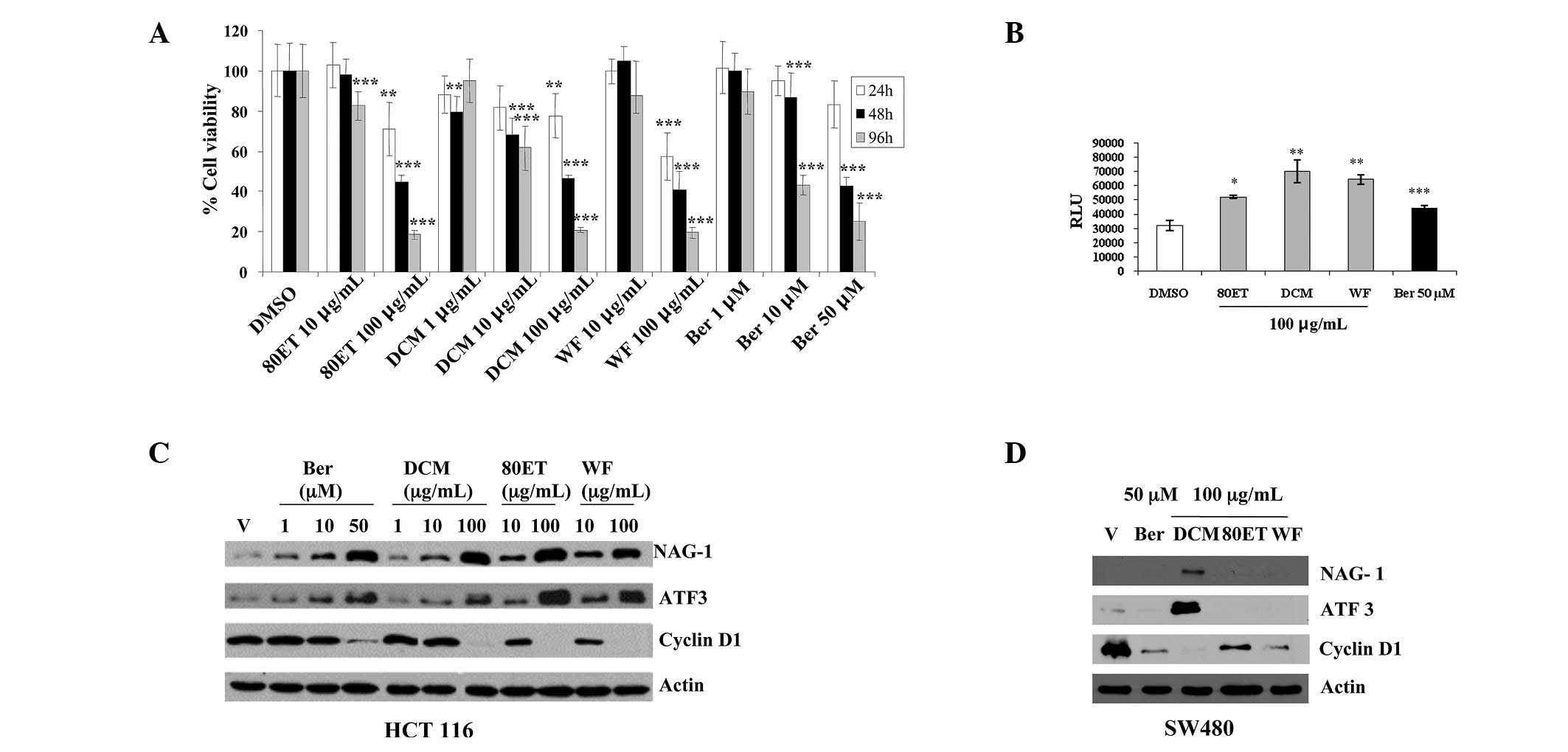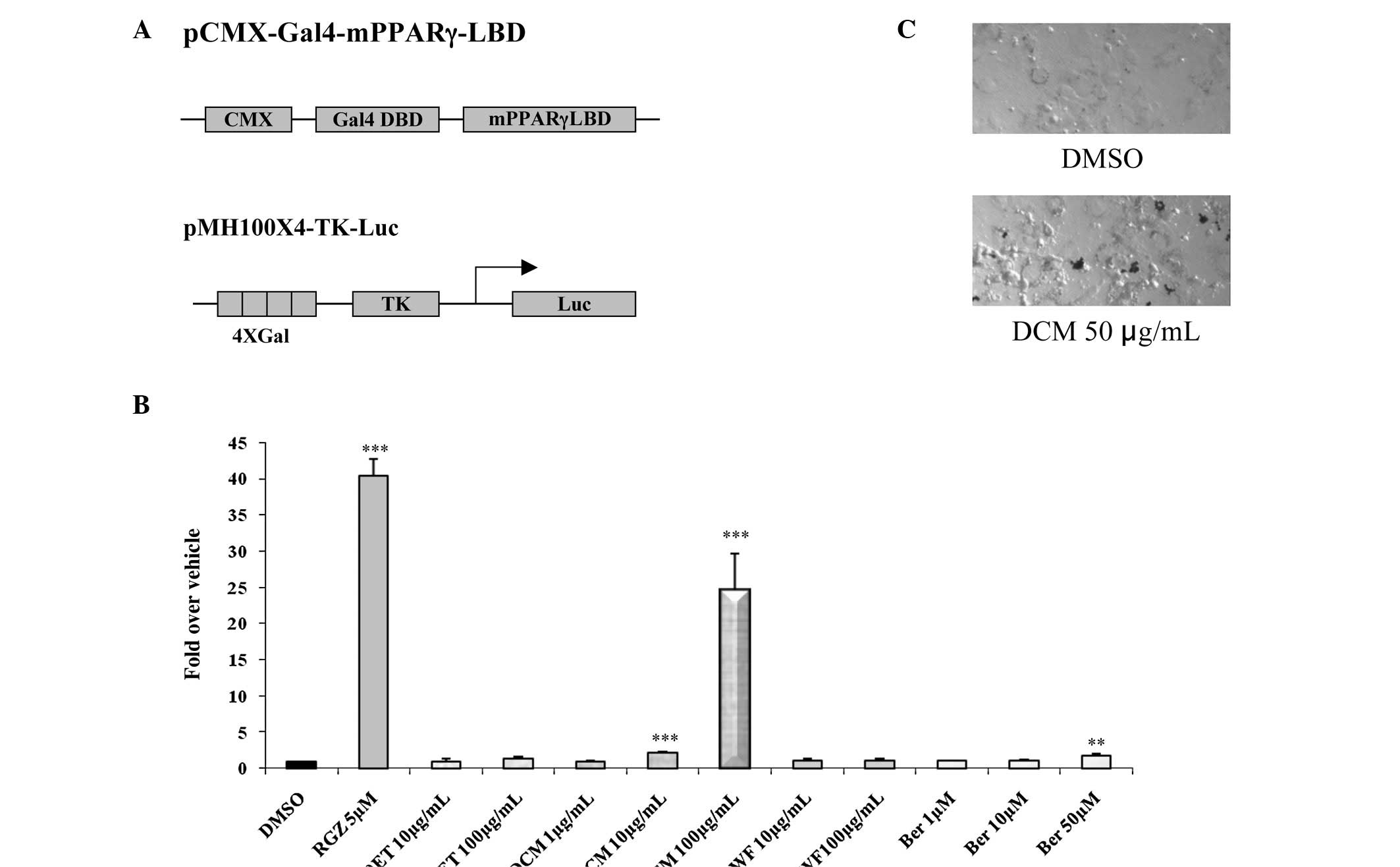|
1.
|
Wattanathorn J, Uabundit N, Itarat W,
Mucimapura S, Laopatarakasem P and Sripanidkulchai B: Neurotoxicity
of Coscinium fenestratum stem, a medicinal plant used in
traditional medicine. Food Chem Toxicol. 44:1327–1333. 2006.
|
|
2.
|
Punitha IS, Rajendran K and Shirwaikar A
and Shirwaikar A: Alcoholic stem extract of Coscinium
fenestratum regulates carbohydrate metabolism and improves
antioxidant status in streptozotocin-nicotinamide induced diabetic
rats. Evid Based Complement Alternat Med. 2:375–381. 2005.
|
|
3.
|
Baek SJ, Kim KS, Nixon JB, Wilson LC and
Eling TE: Cyclooxygenase inhibitors regulate the expression of a
TGF-beta superfamily member that has proapoptotic and
antitumorigenic activities. Mol Pharmacol. 59:901–908.
2001.PubMed/NCBI
|
|
4.
|
Martinez JM, Sali T, Okazaki R, Anna C,
Hollingshead M, Hose C, Monks A, Walker NJ, Baek SJ and Eling TE:
Drug-induced expression of nonsteroidal anti-inflammatory
drug-activated gene/macrophage inhibitory
cytokine-1/prostate-derived factor, a putative tumor suppressor,
inhibits tumor growth. J Pharmacol Exp Ther. 318:899–906. 2006.
View Article : Google Scholar
|
|
5.
|
Baek SJ, Kim JS, Jackson FR, Eling TE,
McEntee MF and Lee SH: Epicatechin gallate-induced expression of
NAG-1 is associated with growth inhibition and apoptosis in colon
cancer cells. Carcinogenesis. 25:2425–2432. 2004. View Article : Google Scholar : PubMed/NCBI
|
|
6.
|
Baek SJ, Wilson LC and Eling TE:
Resveratrol enhances the expression of non-steroidal
anti-inflammatory drug-activated gene (NAG-1) by increasing the
expression of p53. Carcinogenesis. 23:425–434. 2002. View Article : Google Scholar : PubMed/NCBI
|
|
7.
|
Piyanuch R, Sukhthankar M, Wandee G and
Baek SJ: Berberine, a natural isoquinoline alkaloid, induces NAG-1
and ATF3 expression in human colorectal cancer cells. Cancer Lett.
258:230–240. 2007. View Article : Google Scholar : PubMed/NCBI
|
|
8.
|
Lee SH, Cekanova M and Baek SJ: Multiple
mechanisms are involved in 6-gingerol-induced cell growth arrest
and apoptosis in human colorectal cancer cells. Mol Carcinog.
47:197–208. 2008. View
Article : Google Scholar : PubMed/NCBI
|
|
9.
|
Cho KN, Sukhthankar M, Lee SH, Yoon JH and
Baek SJ: Green tea catechin (-)-epicatechin gallate induces tumour
suppressor protein ATF3 via eGR-1 activation. Eur J Cancer.
43:2404–2412. 2007. View Article : Google Scholar : PubMed/NCBI
|
|
10.
|
Lu D, Wolfgang CD and Hai T: Activating
transcription factor 3, a stress-inducible gene, suppresses
Ras-stimulated tumorigenesis. J Biol Chem. 281:10473–10481. 2006.
View Article : Google Scholar : PubMed/NCBI
|
|
11.
|
Alao JP: The regulation of cyclin D1
degradation: roles in cancer development and the potential for
therapeutic invention. Mol Cancer. 6:242007. View Article : Google Scholar : PubMed/NCBI
|
|
12.
|
Arber N, Sutter T, Miyake M, Kahn SM,
Venkatraj VS, Sobrino A, Warburton D, Holt PR and Weinstein IB:
Increased expression of cyclin D1 and the Rb tumor suppressor gene
in c-K-ras transformed rat enterocytes. Oncogene. 12:1903–1908.
1996.PubMed/NCBI
|
|
13.
|
Ratschiller D, Heighway J, Gugger M,
Kappeler A, Pirnia F, Schmid RA, Borner MM and Betticher DC: Cyclin
D1 overexpression in bronchial epithelia of patients with lung
cancer is associated with smoking and predicts survival. J Clin
Oncol. 21:2085–2093. 2003. View Article : Google Scholar : PubMed/NCBI
|
|
14.
|
Huang JW, Shiau CW, Yang YT, Kulp SK, Chen
KF, Brueggemeier RW, Shapiro CL and Chen CS: Peroxisome
proliferator-activated receptor gamma-independent ablation of
cyclin D1 by thiazolidinediones and their derivatives in breast
cancer cells. Mol Pharmacol. 67:1342–1348. 2005. View Article : Google Scholar
|
|
15.
|
Deep G, Singh RP, Agarwal C, Kroll DJ and
Agarwal R: Silymarin and silibinin cause G1 and G2-M cell cycle
arrest via distinct circuitries in human prostate cancer PC3 cells:
a comparison of flavanone silibinin with flavanolignan mixture
silymarin. Oncogene. 25:1053–1069. 2006. View Article : Google Scholar : PubMed/NCBI
|
|
16.
|
Stepulak A, Sifringer M, Rzeski W,
Endesfelder S, Gratopp A, Pohl EE, Bittigau P, Felderhoff-Mueser U,
Kaindl AM, Buhrer C, Hansen HH, Stryjecka-Zimmer M, Turski L and
Ikonomidou C: NMDA antagonist inhibits the extracellular
signal-regulated kinase pathway and suppresses cancer growth. Proc
Natl Acad Sci USA. 102:15605–15610. 2005. View Article : Google Scholar : PubMed/NCBI
|
|
17.
|
Barak Y, Nelson MC, Ong ES, Jones YZ,
Ruiz-Lozano P, Chien KR, Koder A and Evans RM: PPAR gamma is
required for placental, cardiac, and adipose tissue development.
Mol Cell. 4:585–595. 1999. View Article : Google Scholar : PubMed/NCBI
|
|
18.
|
Bren-Mattison Y, van Putten V, Chan D,
Winn R, Geraci MW and Nemenoff RA: Peroxisome
proliferator-activated receptor-gamma [PPAR(gamma)] inhibits
tumorigenesis by reversing the undifferentiated phenotype of
metastatic non-small cell lung cancer cells (NSCLC). Oncogene.
24:1412–1422. 2005.
|
|
19.
|
Vignati S, Albertini V, Rinaldi A, Kwee I,
Riva C, Oldrini R, Capella C, Bertoni F, Carbone GM and Catapano
CV: Cellular and molecular consequences of peroxisome
proliferator-activated receptor-gamma activation in ovarian cancer
cells. Neoplasia. 8:851–861. 2006. View Article : Google Scholar : PubMed/NCBI
|
|
20.
|
Elstner E, Muller C, Koshizuka K,
Williamson EA, Park D, Asou H, Shintaku P, Said JW, Heber D and
Koeffler HP: Ligands for peroxisome proliferator-activated
receptorgamma and retinoic acid receptor inhibit growth and induce
apoptosis of human breast cancer cells in vitro and in BNX mice.
Proc Natl Acad Sci USA. 95:8806–8811. 1998. View Article : Google Scholar : PubMed/NCBI
|
|
21.
|
Baek SJ, Wilson LC, Hsi LC and Eling TE:
Troglitazone, a peroxisome proliferator-activated receptor gamma
(PPAR gamma) ligand, selectively induces the early growth
response-1 gene independently of PPAR gamma. A novel mechanism for
its anti-tumorigenic activity. J Biol Chem. 278:5845–5853. 2003.
View Article : Google Scholar
|
|
22.
|
Sarraf P, Mueller E, Smith WM, Wright HM,
Kum JB, Aaltonen LA, De la Chapelle A, Spiegelman BM and Eng C:
Loss-of-function mutations in PPAR gamma associated with human
colon cancer. Mol Cell. 3:799–804. 1999. View Article : Google Scholar : PubMed/NCBI
|
|
23.
|
Cekanova M, Yuan JS, Li X, Kim K and Baek
SJ: Gene alterations by peroxisome proliferator-activated receptor
gamma agonists in human colorectal cancer cells. Int J Oncol.
32:809–819. 2008.PubMed/NCBI
|
|
24.
|
Yamaguchi K, Lee SH, Eling TE and Baek SJ:
A novel peroxisome proliferator-activated receptor gamma ligand,
MCC-555, induces apoptosis via posttranscriptional regulation of
NAG-1 in colorectal cancer cells. Mol Cancer Ther. 5:1352–1361.
2006. View Article : Google Scholar
|
|
25.
|
Rungsimakan S: Pharmacognostic Properties
of Khamin Khruea. Department of Pharmacognosy, Chulalongkorn
University; Bangkok: pp. 1882001
|
|
26.
|
Rojsanga P, Gritsanapan W and Suntornsuk
L: Determination of berberine content in the stem extracts of
Coscinium fenestratum by TLC densitometry. Med Princ Pract.
15:373–378. 2006. View Article : Google Scholar : PubMed/NCBI
|
|
27.
|
Wongcome T, Panthong A, Jesadanont S,
Kanjanapothi D, Taesotikul T and Lertprasertsuke N: Hypotensive
effect and toxicology of the extract from Coscinium
fenestratum (Gaertn.) Colebr. J Ethnopharmacol. 111:468–475.
2007. View Article : Google Scholar : PubMed/NCBI
|
|
28.
|
Malhotra S, Taneja SC and Dhar KL: Minor
alkaloids from Coscinium fenestatum. Phytochemistry.
28:1998–1999. 1989. View Article : Google Scholar
|
|
29.
|
Pinho PMM, Pinto MMM, Kijjoa A, Pharadai
K, Diaz JG and HerZ W: Protoberberine alkaloids from Coscinium
fenestratum. Phytochemistry. 31:1403–1407. 1992. View Article : Google Scholar
|
|
30.
|
Siwon J, Verpoorte R, van Essen GFA and
Baerheim Svendsen A: Studies on Indonesian medicinal plants III.
The alkaloids of Coscinium fenestratum. Planta Med. 38:24–32. 1980.
View Article : Google Scholar
|
|
31.
|
Ueda JY, Tezuka Y, Banskota AH, Le Tran Q,
Tran QK, Harimaya Y, Saiki I and Kadota S: Antiproliferative
activity of Vietnamese medicinal plants. Biol Pharm Bull.
25:753–760. 2002. View Article : Google Scholar : PubMed/NCBI
|
|
32.
|
Baek SJ, Okazaki R, Lee SH, Martinez J,
Kim JS, Yamaguchi K, Mishina Y, Martin DW, Shoieb A, McEntee MF and
Eling TE: Nonsteroidal anti-inflammatory drug-activated gene-1 over
expression in transgenic mice suppresses intestinal neoplasia.
Gastroenterology. 131:1553–1560. 2006. View Article : Google Scholar : PubMed/NCBI
|
|
33.
|
Morgan DO: Principles of CDK regulation.
Nature. 374:131–134. 1995. View
Article : Google Scholar : PubMed/NCBI
|
|
34.
|
Shukla S and Gupta S: Apigenin-induced
cell cycle arrest is mediated by modulation of MAPK, PI3K-Akt and
loss of cyclin D1 associated retinoblastoma dephosphorylation in
human prostate cancer cells. Cell Cycle. 6:1102–1114. 2007.
View Article : Google Scholar
|
|
35.
|
Lim YC, Lee SH, Song MH, Yamaguchi K, Yoon
JH, Choi EC and Baek SJ: Growth inhibition and apoptosis by
(-)-epicatechin gallate are mediated by cyclin D1 suppression in
head and neck squamous carcinoma cells. Eur J Cancer. 42:3260–3266.
2006. View Article : Google Scholar : PubMed/NCBI
|
|
36.
|
Baek SJ, Wilson LC and Eling TE:
Resveratrol enhances the expression of non-steroidal
anti-inflammatory drug-activated gene (NAG-1) by increasing the
expression of p53. Carcinogenesis. 23:425–432. 2002. View Article : Google Scholar : PubMed/NCBI
|
|
37.
|
Yan C, Jamaluddin MS, Aggarwal B, Myers J
and Boyd DD: Gene expression profiling identifies activating
transcription factor 3 as a novel contributor to the proapoptotic
effect of curcumin. Mol Cancer Ther. 4:233–241. 2005.PubMed/NCBI
|
|
38.
|
Yin J, Hu R, Chen M, Tang J, Li F, Yang Y
and Chen J: Effects of berberine on glucose metabolism in vitro.
Metabolism. 51:1439–1443. 2002. View Article : Google Scholar : PubMed/NCBI
|












